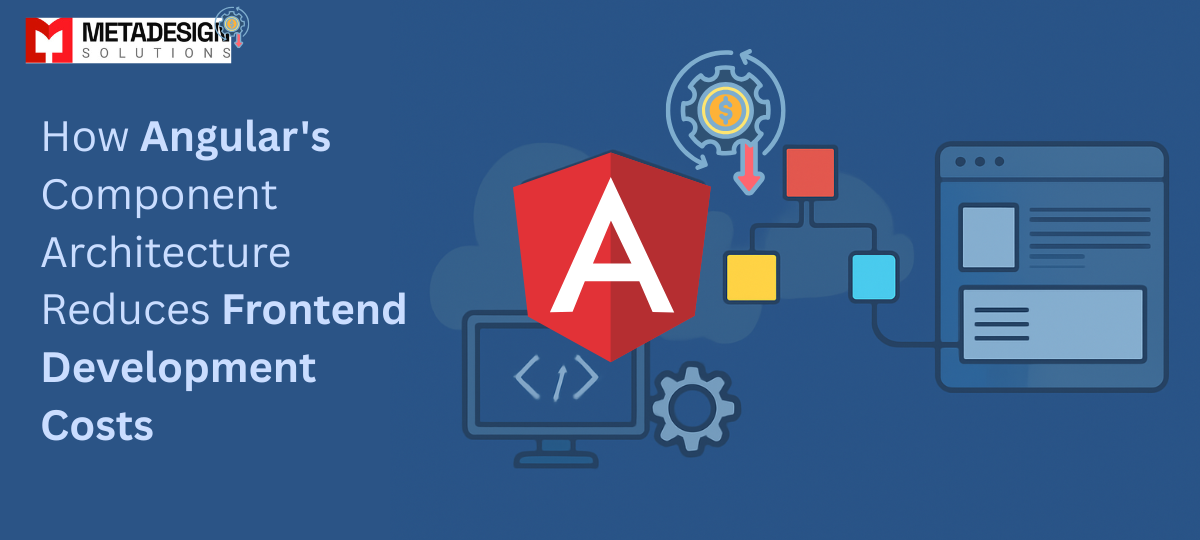Frontend development budgets soaring due to complexity and maintenance issues? You’re not alone. In today’s enterprise environment, managing a large, complex Single-Page Application (SPA) often leads to ballooning costs, slow feature delivery, and crippling technical debt. The traditional monolithic approach simply doesn’t scale efficiently.
As an expert in enterprise-grade web architecture, my thesis is clear: Angular’s opinionated Component Architecture is the definitive solution for reducing long-term frontend development and maintenance costs, turning your application into an asset rather than a financial liability.
Key Value Proposition | Direct Business Impact |
Component Reusability | Faster Time-to-Market (Reduced Build Time) |
Code Consistency (TypeScript) | Lower Onboarding Costs (Rapid Developer Productivity) |
Isolation & Modularity | Drastically Reduced Maintenance & Debugging Costs |
The Core Mechanism: Component-Based Architecture (CBA)
The foundation of Angular’s cost-saving power lies in its Component-Based Architecture (CBA). This is not just a coding pattern; it is a project management strategy designed for large, distributed teams.
What is an Angular Component?
Think of a component as a self-contained, functional LEGO block for your application. It encapsulates everything needed for a specific piece of UI and its logic, ensuring maximum isolation and reusability. Each component consists of three key parts:
- The Template (HTML): The structure and view.
- The Class (TypeScript): The data, behavior, and business logic.
- The Styles (CSS): The appearance, scoped only to that component.
Reusability: The Multiplier Effect on ROI
The most immediate cost benefit of CBA is reusability. When you build a complex element—like a date picker, a custom user profile card, or a dynamic data table—you build it once, rigorously test it, and then deploy it across dozens of different views or even separate applications (using technologies like Angular Elements or Micro Frontends).
This eliminates the need for developers to “reinvent the wheel” for every screen, transforming development from a repetitive coding exercise into a highly efficient assembly process. The marginal cost of adding a new feature that uses existing components approaches zero.
Maintainability and Isolation
In a traditional monolithic application, updating a simple feature might require sifting through thousands of lines of code, risking a cascading failure (a “ripple effect” bug). Angular’s component model prevents this through strong encapsulation.
- Self-Correction: A bug fix or feature update within a component is isolated. Because its behavior and styling are scoped, you can confidently modify a single unit without fear of introducing regressions in unrelated parts of the application.
- Targeted Debugging: When an issue is reported, a developer immediately knows which component is responsible, cutting down on the most expensive part of the development lifecycle: debugging time.
Direct Cost Reduction Factors
Angular translates architectural purity directly into financial savings across your project lifecycle.
1. Reduced Development Time (Faster Time-to-Market)
By leveraging a library of proven, pre-tested components, development velocity is accelerated. New features can be assembled, not coded from scratch.
Furthermore, Angular development services is highly opinionated. This means it imposes a structured way of doing things (e.g., modularity via NgModule or Standalone Components). While this can feel restrictive to some, for an enterprise, it means a predictable codebase that accelerates development, especially in the crucial first six months.
2. Lower Maintenance and Technical Debt Costs
Maintenance often consumes over 50% of the total software budget post-launch. Angular minimizes this:
- Clear Separation of Concerns: By strictly separating the UI (Component) from the data fetching/manipulation (Service), Angular ensures that complex updates don’t require total refactoring.
- Simplified Upgrades: The Angular team provides powerful, automated tools (ng update) to manage framework and dependency upgrades, drastically reducing the cost and risk associated with staying on a modern, secure version of the platform.
3. Lower Onboarding Costs (TypeScript & Tooling)
Developer turnover is a reality. The cost of bringing a new mid-level engineer up to full productivity can be significant. Angular mitigates this with TypeScript and robust tooling.
- TypeScript Enforced Consistency: TypeScript, a superset of JavaScript, enforces static typing. This acts as immediate, living documentation for the codebase. A new developer can understand what data a function expects and what it returns without having to trace runtime execution, which can cut onboarding time by an estimated 30-50%.
Immediate Error Feedback: Typescript catches whole classes of errors (e.g., typos, invalid object properties) during development, preventing costly runtime failures in production.
Drive Down Frontend Development Costs with Angular's Component Architecture
Leverage Angular’s modular component system to minimize development time and cost. Discover how this approach leads to better code reuse, scalability, and easier maintenance.
Angular’s Supporting Tools for Cost Savings
The component architecture is powerful, but Angular’s ecosystem tools amplify the savings.
1. The Angular CLI: Automation is Cost Reduction
The Angular Command Line Interface (CLI) is an indispensable tool that automates repetitive, time-consuming tasks.
CLI Action | Cost-Saving Benefit |
ng generate component | Instantly creates the component files with correct boilerplate and testing harness. Saves setup time. |
ng test / ng lint | Standardizes and automates unit testing and coding standards. Reduces QA hours. |
ng build –prod | Automatically applies optimizations like Ahead-of-Time (AoT) compilation and tree-shaking. Reduces load times, improving user retention and performance ROI. |
2. Dependency Injection (DI): The Key to Testability
Angular’s Dependency Injection (DI) system is central to component testability. Services (where business logic resides) are “injected” into components rather than hard-coded.
This means you can easily swap out a real, expensive, API-calling service with a lightweight mock service during testing. This isolation allows for fast, reliable unit tests, making Continuous Integration/Continuous Delivery (CI/CD) pipelines more robust and further reducing the costs associated with QA and regression failures.
Conclusion: Components are the Cornerstone of Long-Term ROI
Choosing a frontend framework for an enterprise application is fundamentally a business decision about long-term cost management. Angular’s Component Architecture, supported by TypeScript, a powerful CLI, and robust testing mechanisms, is a disciplined approach that ensures predictable scalability and high maintainability.
By prioritizing reusable, isolated, and highly-testable components, Angular projects inherently reduce development time, minimize technical debt, and ensure that your development team’s efforts are spent on delivering value, not fixing yesterday’s problems.
Ready to build a scalable, cost-efficient frontend platform? Stop paying the “monolith tax.” Contact our certified Angular consultants today to architect a solution designed for maximum ROI.
Related Hashtags:
#Angular #FrontendDevelopment #WebDevelopment #CostReduction #SoftwareDevelopment #TechInnovation #ComponentArchitecture #CodeEfficiency #WebDevTips



